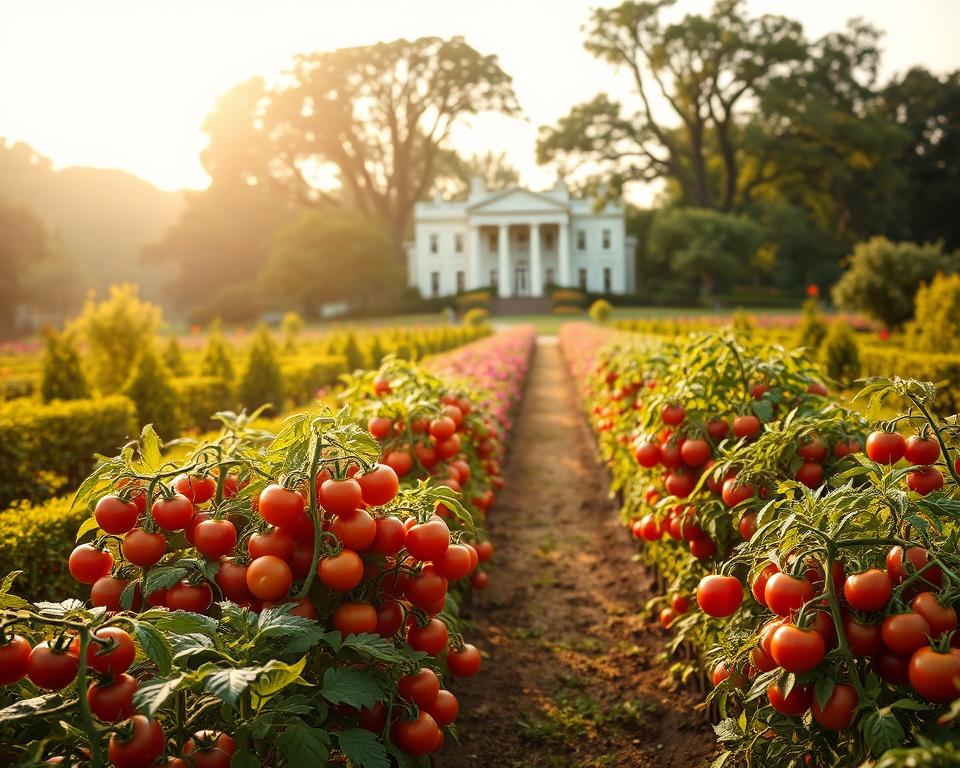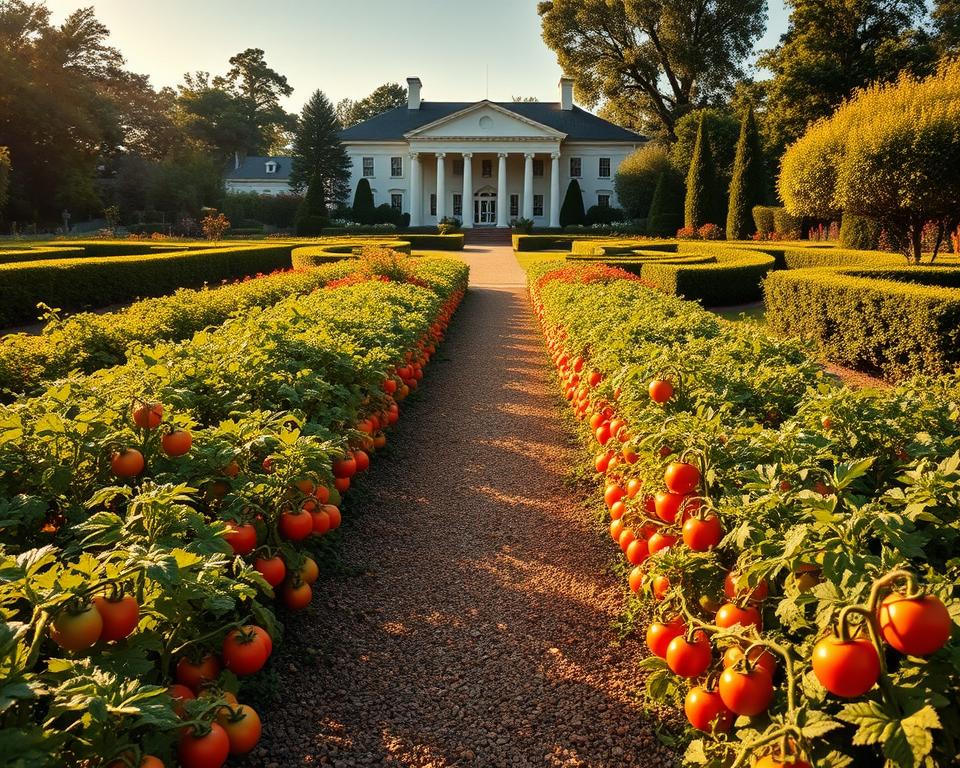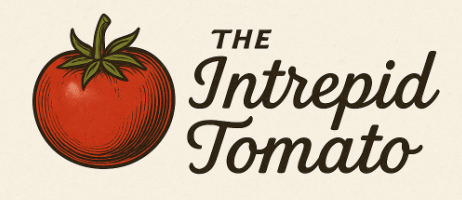Thomas Jefferson’s Tomato Obsession and the Birth of American Gardening
At Monticello, Thomas Jefferson had a deep love for gardening. He grew over 330 varieties of 99 different vegetables and herbs. He was always trying new things to add exciting flavors to meals.
We look into how Jefferson’s love for tomatoes helped make them popular. His passion for gardening set the stage for American gardening today.
By studying Jefferson’s gardening experiments, we learn about the start of American gardening. His tomato obsession greatly influenced the country’s food culture.
The Revolutionary Gardener: Jefferson’s Passion for Plants
Thomas Jefferson was more than just a founding father. He was also a passionate gardener. His love for plants and gardening was a big part of his vision for a prosperous America.
A Founding Father with Green Thumbs
Jefferson loved trying new plants and was excited about vegetables. He even experimented with tomatoes in his garden at Monticello.
The Garden Laboratory at Monticello
At Monticello, Jefferson created a garden that was way ahead of its time. It was a place where he tested new plants and gardening methods. Peter Hatch, the estate’s head gardener, said Jefferson believed plants could change society.
Jefferson’s Agricultural Philosophy
Jefferson’s gardening was all about trying new things and being innovative. He thought new crops and farming methods were key to America’s future.
Experimental Approach to Cultivation
His garden at Monticello showed his dedication to innovation and gardening.
Looking into Jefferson’s gardening shows us his innovative spirit. It also shows how he influenced American gardening. The story of Thomas Jefferson’s tomatoes is a great example of his impact on American food.
Thomas Jefferson Tomatoes: From European Curiosity to American Staple
Jefferson’s gardening at Monticello helped introduce tomatoes to American cuisine. Once seen as “poison apples,” tomatoes became a common sight in gardens, thanks to Jefferson.
The Tomato’s Journey to Jefferson’s Garden
Tomatoes arrived in Europe in the 16th century. They were initially doubted because of their family ties to poisonous plants. But by the late 1700s, they became popular in European cooking. Jefferson, with his love for new foods and gardening, was among the first to grow tomatoes in America.
Jefferson enjoyed tomatoes from 1809 to 1824, as his garden records show. He grew many varieties at Monticello, always looking to improve their cultivation.
Overcoming Colonial Suspicions of the “Poison Apple”
Even though tomatoes were popular in Europe, many American colonists were wary. Jefferson’s efforts to grow and eat tomatoes helped change this. By doing so, he proved they were safe and tasty.

Jefferson’s Tomato Varieties and Growing Techniques
Jefferson grew many tomato types at Monticello. His records show he used different methods to grow them, like using cold frames and hotbeds to start seedlings early.
Early Cultivation Challenges
One big challenge Jefferson faced was Virginia’s short growing season. To beat this, he used cold frames and hotbeds to start seedlings early.
Successful Growing Methods
Jefferson’s garden journal details his tomato successes. He noted which varieties did well and how he grew them. His careful records helped him improve his growing techniques over time.
| Tomato Variety | Growing Method | Yield |
|---|---|---|
| Red Cherry | Cold Frame | High |
| Yellow Pear | Hotbed | Moderate |
| Orange Oxheart | Direct Sowing | High |
By looking at Jefferson’s tomato growing methods, we see how he helped make tomatoes popular in America.
Inside Jefferson’s Monticello Garden: A Tomato Showcase
The gardens at Monticello were more than a hobby for Jefferson. They were a place for him to experiment with different tomato varieties. We learn about his careful planning and dedication to growing tomatoes in his garden.
Layout and Design of Jefferson’s Vegetable Garden
Jefferson’s vegetable garden at Monticello was carefully designed. It had a complex layout to make the most of space and to rotate crops. Tomatoes were a key part of the garden.
Peter Hatch tells us that Jefferson grew over 330 varieties of vegetables and herbs. This shows his diverse interests and experimental spirit in gardening.

The garden used innovative techniques for its time. It had cold frames and mounds to grow crops longer. This allowed Jefferson to grow a wide range of crops, including tomatoes.
Documented Tomato Varieties in Jefferson’s Collection
Jefferson grew many tomato types, some of which were rare for his time. His garden journal shows the planting and harvesting of many varieties. This highlights his interest in different flavors and characteristics.
Some of the varieties he grew include ‘Red Cherry,’ ‘Orange Pear,’ and ‘White Apple.’ These show the variety in his tomato collection.
| Tomato Variety | Description | Harvest Date |
|---|---|---|
| Red Cherry | Small, round, red fruit | July 15 |
| Orange Pear | Pear-shaped, orange fruit | August 1 |
| White Apple | Apple-shaped, white fruit | July 20 |
Jefferson’s Meticulous Record-Keeping and Garden Journal
Jefferson’s garden journal is a valuable resource. It includes notes on planting, weather, and harvests. This gives us a detailed look at his gardening practices.
Through his journal, we see Jefferson’s dedication to his tomatoes. He paid close attention to every detail of his gardening.
From Presidential Table to American Farms: Jefferson’s Tomato Legacy
Thomas Jefferson loved tomatoes and it changed American food. As President, he showed off his favorite fruits at the White House. This made tomatoes more popular in America.
Serving Tomatoes at Presidential Dinners
Jefferson brought tomatoes to presidential dinners. This helped people see they weren’t poisonous. It made tomatoes a part of fine dining in America.
Distributing Seeds Across the Young Nation
Jefferson gave seeds to friends and other leaders. This spread tomatoes and helped grow new kinds in different places.
Jefferson’s Influence on American Culinary Traditions
Jefferson’s love for tomatoes changed American food. Tomatoes are now in many dishes, like sauces, salads, soups, and sandwiches.
| Year | Tomato Varieties | Culinary Uses |
|---|---|---|
| 1800 | Red Cherry Tomatoes | Salads, Sauces |
| 1810 | Yellow Pear Tomatoes | Pickling, Garnishes |
| 1820 | Large Red Tomatoes | Soups, Sandwiches |
Jefferson’s love for tomatoes made a big impact on American food. He changed how we eat and grow tomatoes.
Growing Jefferson’s Tomato Legacy in Modern Gardens
Thomas Jefferson’s love for tomatoes has made a big impact on American gardens. Today, we can grow the same tomatoes he had at Monticello. This lets us connect with nature and appreciate the food history he helped create.
Growing your own food, like Jefferson did, inspires many gardeners. Monticello’s garden is a treasure trove of heirloom tomatoes. We can try the same flavors and textures that Jefferson enjoyed. We can also use his gardening methods in our own gardens.
By saving heirloom tomatoes and using Jefferson’s gardening ways, we celebrate his legacy. We also deepen our bond with the earth and its gifts. As we care for our gardens, we join a long tradition. We learn to value the joy of growing and enjoying fresh, tasty tomatoes.

